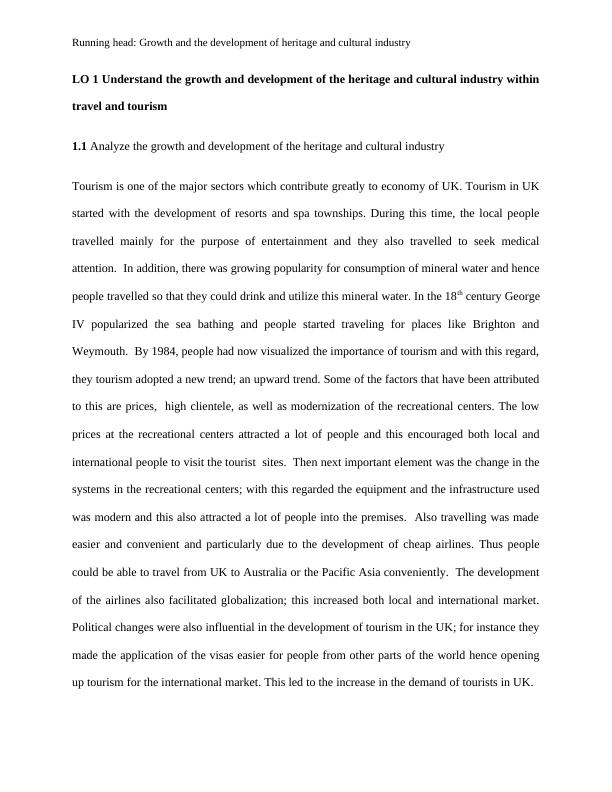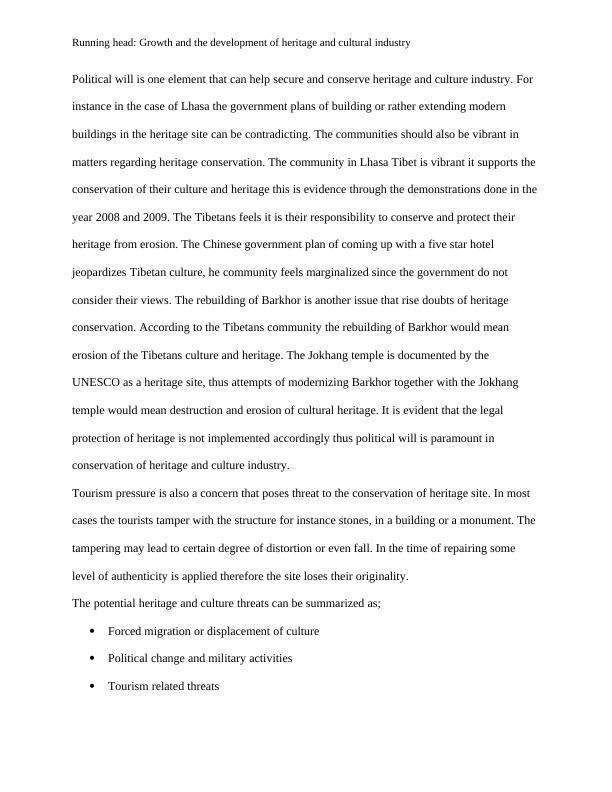Ask a question from expert
Growth & Development Of The Heritage And Cultural Industry|Assignment
16 Pages4240 Words134 Views
Added on 2020-02-03
Growth & Development Of The Heritage And Cultural Industry|Assignment
Added on 2020-02-03
BookmarkShareRelated Documents
Running head: Growth and the development of heritage and cultural industry Growth and the development of heritage and cultural industry Name:Date:

Running head: Growth and the development of heritage and cultural industry LO 1 Understand the growth and development of the heritage and cultural industry withintravel and tourism 1.1Analyze the growth and development of the heritage and cultural industry Tourism is one of the major sectors which contribute greatly to economy of UK. Tourism in UKstarted with the development of resorts and spa townships. During this time, the local peopletravelled mainly for the purpose of entertainment and they also travelled to seek medicalattention. In addition, there was growing popularity for consumption of mineral water and hencepeople travelled so that they could drink and utilize this mineral water. In the 18th century GeorgeIV popularized the sea bathing and people started traveling for places like Brighton andWeymouth. By 1984, people had now visualized the importance of tourism and with this regard,they tourism adopted a new trend; an upward trend. Some of the factors that have been attributedto this are prices, high clientele, as well as modernization of the recreational centers. The lowprices at the recreational centers attracted a lot of people and this encouraged both local andinternational people to visit the tourist sites. Then next important element was the change in thesystems in the recreational centers; with this regarded the equipment and the infrastructure usedwas modern and this also attracted a lot of people into the premises. Also travelling was madeeasier and convenient and particularly due to the development of cheap airlines. Thus peoplecould be able to travel from UK to Australia or the Pacific Asia conveniently. The developmentof the airlines also facilitated globalization; this increased both local and international market.Political changes were also influential in the development of tourism in the UK; for instance theymade the application of the visas easier for people from other parts of the world hence openingup tourism for the international market. This led to the increase in the demand of tourists in UK.

Running head: Growth and the development of heritage and cultural industry In 1900, Atlantic City began with around 400 new hotels, and villas which were vacationdestination. This started as smaller working weeks as well as paid holiday business in UK. Bythe year 1901, the tourism industry introduced the concept of holiday catalogue whichconcentrated on the travelling aspect as an important component in tourism. Nevertheless, thisindustry has its own challenges since between 1914 and 1918 it faced depression. This wasattributed to the First World War as many people preferred staying indoors because everythingwas in dismay. However, between 1920 and 1930 the tourism started thriving with Thomas Cookinitiated the standard London-Paris air facility as well as motor trains in UK which facilitated thetransport. By 1939, the sea voyages, and the private transports developed, by this year the longbus facilities had served more than 37 million travelers.1.2Discuss potential conflicts in the conservation of heritage and cultural resources using thecase study of Lhasa, TibetHeritage site conservation measures encounter a number of threats and risks during their implementation. Some of the problems associated with cultural heritage conservation include; development pressure, collective and social behavior, lack of enough maintenance and low conservation standards. A well-defined recognition of heritage site and appreciation should be upheld in order to conserve the heritage. However if the conservation measure cannot be taken care of possible decay of culture and heritage can be the consequences. Mass awareness is one ofthe initiatives that can be implemented to teach the public the significance of the site. Planning should also be done basing the strategy on previous events and with future anticipation. Therefore to counter the heritage conservation risks, we should be proactive in the sense of response preparedness and recovery.

Running head: Growth and the development of heritage and cultural industry Political will is one element that can help secure and conserve heritage and culture industry. For instance in the case of Lhasa the government plans of building or rather extending modern buildings in the heritage site can be contradicting. The communities should also be vibrant in matters regarding heritage conservation. The community in Lhasa Tibet is vibrant it supports the conservation of their culture and heritage this is evidence through the demonstrations done in theyear 2008 and 2009. The Tibetans feels it is their responsibility to conserve and protect their heritage from erosion. The Chinese government plan of coming up with a five star hotel jeopardizes Tibetan culture, he community feels marginalized since the government do not consider their views. The rebuilding of Barkhor is another issue that rise doubts of heritage conservation. According to the Tibetans community the rebuilding of Barkhor would mean erosion of the Tibetans culture and heritage. The Jokhang temple is documented by the UNESCO as a heritage site, thus attempts of modernizing Barkhor together with the Jokhang temple would mean destruction and erosion of cultural heritage. It is evident that the legal protection of heritage is not implemented accordingly thus political will is paramount in conservation of heritage and culture industry.Tourism pressure is also a concern that poses threat to the conservation of heritage site. In most cases the tourists tamper with the structure for instance stones, in a building or a monument. The tampering may lead to certain degree of distortion or even fall. In the time of repairing some level of authenticity is applied therefore the site loses their originality.The potential heritage and culture threats can be summarized as;Forced migration or displacement of culturePolitical change and military activitiesTourism related threats

End of preview
Want to access all the pages? Upload your documents or become a member.
Related Documents
Development and Growth of Cultural and Heritage Industrylg...
|13
|3918
|206
Growth and Development of Cultural and Heritage Industrylg...
|14
|3164
|41
Growth of Heritage and Cultural Industry in the UKlg...
|13
|3296
|227
InTRODUCTION 3 TASK 13 1.1 The UK heritage and cultural tourism industrylg...
|15
|5270
|96
Heritage & Cultural Tourism Assignmentlg...
|15
|4039
|52
Heritage and Cultural Tourismlg...
|15
|3106
|127